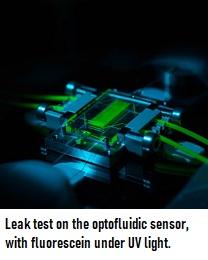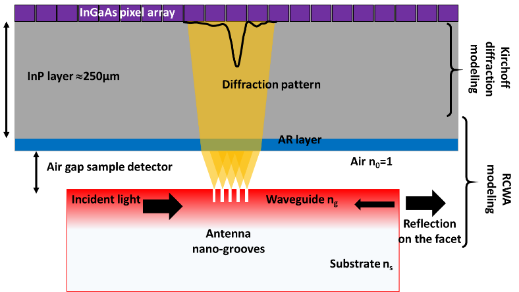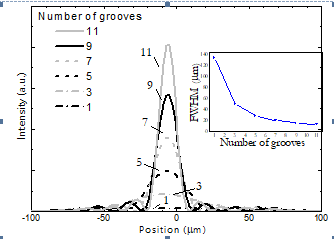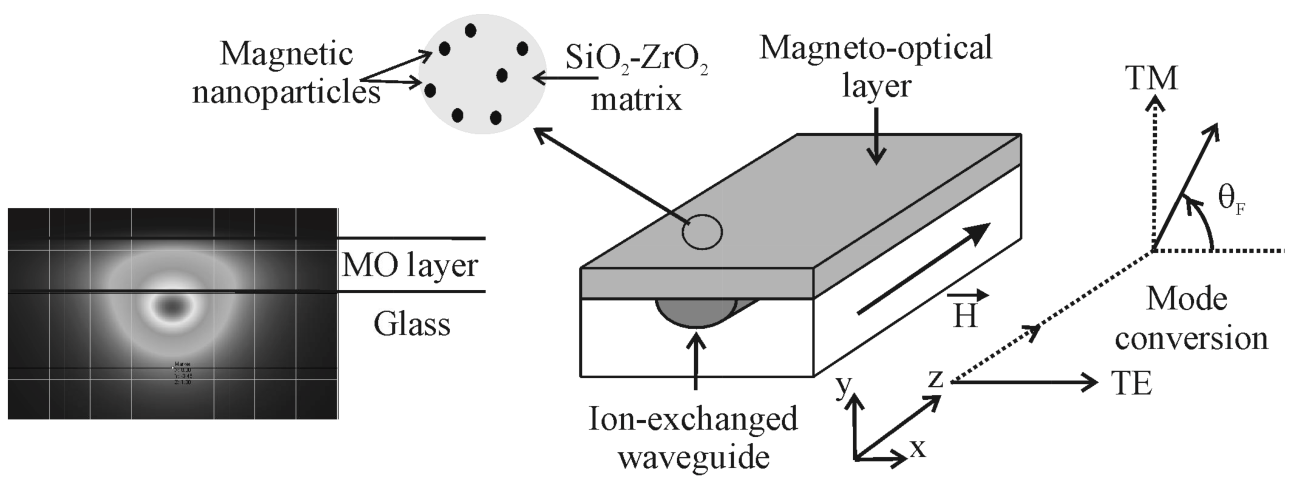Context and objectives
CROMA possesses an integrated glass optics platform historically linked to the development of components for near-infrared telecommunications. On this platform active (optical amplification, DFB lasers, etc.) and passive (duplexers, phasars, interferometers, etc.) functions are developed for the field of optical telecommunications and sensors. We have an expertise in micro-fluidics on glass, which allows us to produce fully integrated opto-fluidic components. Finally, a set of simulation tools developed in the laboratory allows us to model our fabrication processes and simulate the electromagnetic behaviour of the devices manufactured using the AFMM (2D and 3D), RCWA (2D and 3D) and Differential Method with FFF (2D) methods.
Here are some examples of research currently being carried out within this axis:
- Development of waveguides with low losses in the visible range for applications such as biological sensors for health, agri-food and environmental sensors.
- Development of LIDAR sensors and integrated spectrometers.
- Hybridization of fully integrated non-linear and magneto-optical devices on glass.
- Hybridization of optical circuits based on semiconductor materials (silicon and III-V) on glass for monolithic integration of sources and detectors for the fabrication of on-chip integrated sensors.
- Development of glass interposers for the distribution of optical and electrical signals between semiconductor optoelectronic chips.
Detection of plutonium (VI) in an optofluidic device

CROMA worked with the Marcoule CEA to create a novel optofluidic sensor, dedicated to probing fluids that are both chemically agressive and radioactive such as those involved in the reprocessing of spent nuclear fuel.
The device, entirely made on glass, is rugged enough to be exploited in a nuclearized glove box to perform absorption spectroscopy, thanks to optical waveguides made by ion-exchange on glass interacting with a fluidic micro-cuvette.
This allowed the first concentration measurement of plutonium (VI) in nitric acid in a microsystem containing only 20 µl of radioactive liquid. When compared to the 10 ml samples needed for standard measurements, this device paves the way to faster and cheaper analysis of spent nuclear fuel.
Contact: Davide BUCCI
Relevant publications : Microsensing of plutonium with a glass optofluidic device.
Optical Engineering, 2019 => https://hal.archives-ouvertes.fr/hal-02157782
Optical numerical tool development for scattering analysis of diffractive components and color generation
The light scattering from periodic structure is an important subject for different types of applications (Spectrometry, wavelength filter, photovoltaic structures …). For that, numerical modelization tools as RCWA (Rigorous Coupled Wave Analysis) or the DM (differential Method) are developed in our lab. RCWA is efficient for lamellar profiles but this is not the case for continuous profiles especially for TM polarization with grating composed of metal. The DM associated to the FFF has been demonstrated to be a solution. The development of these tools is used in this project to design novel color diffractive components for security application.

Study performed by: Habib Mohamad (PhD), Alain Morand and Pierre Benech
Collaborations:- D. Macias and S. Blaize, INL, Troyes, France
- Mikael Renault, SURYS, Bussy-Saint-Georges, France
Support: this research is supported by the French Research Agency (ANR) through the ANR PRCE project ODISSEA (ANR-16-CE39-0016)
References:
- H. Mohamad, S. Es-Saïdi, A. Morand, P. Benech, D. Macias adn S. Blaize, « Fast Fourier Factorization : a powerful tool for the modelling of non-lamellar metallic gratings compared to the C-method », OWTNM in Malaga, 2019
- A. K. Gonzales-Alcade, R. Salas-Montiel, H. Mohamad, A. Morand, S. Blaize and D. Macias, "Optimization of all-dielectric structures for color generation", Applied optics 57 (14), pp. 3959-3967, 2018.
- H. Mohamad, A. Morand, S. Blaise, D. Macias, P. Benech, « Efficacité de la FFF sur la RCWA et la méthode différentielle appliquée à la diffraction d’un réseau métallique sinusoïdal », Journées Nationales d’Optique Guidée à Toulouse, 2018.- H. Mohamad, A. Morand, P. Benech, S. Blaise « La méthode différentielle associée à la FFF : de l’optique diffractive vers l’optique guidée », GDR Ondes à Marseille, juin 2019.
Nano-grooves scattering centers acting as antenna in integrated optics Fourier transform spectrometers
Stationary Wave Integrated Fourier Transform Spectrometers (SWIFTS) are based on the sampling of a stationary wave using nano-scattering centers on the surface of a channel waveguide. Single nano-scale scattering centers above the waveguide surface will radiate the sampled signal with wide angular distribution, which is not compatible with the buried detection area of infrared detectors, resulting in crosstalk between pixels. An implementation of multiple diffraction nano-grooves (antenna) for each sampling center is proposed as an alternative solution to improve directivity towards the detector pixel by narrowing the scattering angle of the extracted light. And its efficiency is demonstrated from both modelized and measured far field radiative patterns exhibiting a promising method to be used for future integrated IR-SWIFTS.
Study performed by: Irène Heras (Post-doc) and Alain MorandCollaborations:
- G. Martin, IPAG, Grenoble, France
- N. Courjal, FEMTO-ST, Besançon, France
Support: this research is supported by the French Research Agency (ANR-11-LABX-0013) and FP7 people Marie-Curie Actions (PCOFUND-GA-2013-609102)

Schematic 2D representation of the LN waveguide with a 5 FIB nano-grooves (100x500 nm section) antenna and the IR detector comprised of 128x128 pixel array with 20 µm pixel pitch

- I. Heras, G. Ulliac, E. Le Coarer, P. Benech, N. Courjal, G. Martin, "Improving the vertical radiation pattern issued from multiple nano-groove scattering centers acting as an antenna for future integrated optics Fourier transform spectrometers in the near IR", Optics Letters. 44(3), 2019.A. Morand,
- I. Heras, J. R. Vazquez de Aldana, A. Morand and G. Martin,. “High resolution and wideband integrated optics infrared stationary-wave spectrometer fabricated by ultrafast laser inscription”, Advances in optical and mechanical Technologies for telescopes and instrumentation III, Proceeding of SPIE Volume 10706, 2018.
- M. Bonduelle, G. Martin, A. Morand, G. Zhang, G. Cheng, C. D’amico and R.Stoian, « Laser Written Nano-Antenna and Waveguides devoted to Stationary Wave Sampling in Integrated Optic Spectrometers for the Near Infrared », CLEO Europe 2019 in Munich, poster, 2019
Magneto-optical mode converter on glass
The integration of magneto-optical materials to realize non-reciprocal functions is still a challenging target. Indeed, classical magneto-optical materials require an annealing temperature as high as 700°C, involving strong thermal budget constraints. In this framework, this study shows how it is possible to realize an efficient magneto-optical mode converter integrating a magnetic nanoparticles silica/zirconia composite with an ion-exchanged glass waveguide. Using a sol gel process, a silica/zirconia matrix is doped by magnetic nanoparticles (CoFe2O4) and coated on a glass substrate containing straight channel waveguides made by a silver/sodium ion exchange. The extremities of the guides were previously buried using electric field-assisted burial in order to facilitate light injection. Soft annealing and UV treatment, both compatible with the ion exchange process, have been implemented to finalize the magneto-optical film.
Collaborations:- Laboratoire Hubert Curien, Université Jean-Monnet
- Laboratoire PHENIX, Université Pierre et Marie Curie
Relevant articles :
- Full experimental determination of the optical and magneto-optical characteristics of a hybrid glass waveguide covered by a magnetic nanoparticles doped sol-gel layer
- Birefringence measurements in optical waveguides
- Efficient magneto-optical mode converter on glass




